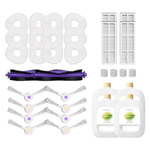Are you considering a robot vacuum but unsure about the importance of suction power? You're not alone! Suction power is a critical factor in how well your robot vacuum cleans. In this blog, we'll explain what suction power is, why it matters, and how to choose the right level for your needs. By the end, you'll be equipped with the knowledge to make an informed decision. Let's get started!
Do You Understand Suction Power?
Definition of Suction Power
Suction power is the force a vacuum uses to pick up dirt, dust, and debris. It's measured in Pascals (Pa), where a higher Pa means stronger suction.
-
Pascals (Pa): This is the unit used to measure how strong the vacuum’s suction is. Higher Pa = stronger suction.
-
Dust Pick-Up Rate (DPU): This measures how well a vacuum picks up dirt. A higher DPU means the vacuum is better at cleaning.
-
Airflow: This refers to the amount of air the vacuum moves. Good airflow helps maintain suction and carry dirt into the dustbin.
In simple terms, the higher the Pa, DPU, and airflow, the better the vacuum is at cleaning your floors!
Factors Influencing Suction Power
Several factors influence the suction power of a robot vacuum:
Motor Strength: The motor is the heart of the vacuum, and its strength directly impacts suction power. A more powerful motor can generate higher suction, which improves cleaning efficiency.
Airflow Design: The design of the airflow path inside the vacuum also affects suction power. Efficient design ensures that air flows smoothly from the floor to the dustbin, maintaining strong suction throughout the cleaning process.
Filtration Systems: High-quality filters, such as HEPA filters, play a significant role. These filters trap fine particles and allergens, ensuring that the vacuum maintains consistent suction by preventing clogging and maintaining airflow.
Brush Design: The design and effectiveness of the brush heads also impact suction. Brushes help agitate dirt, loosening it from the floor and allowing the vacuum to pull it up. Brushes that are poorly designed or become tangled (especially with pet hair) can reduce suction efficiency, whereas innovative brush designs, like tangle-free or floating brushes, ensure that dirt is efficiently gathered and vacuumed.
Dustbin Size and Design: The dustbin size and design also contribute to suction power. If the dustbin is too small or improperly designed, it can fill up quickly and reduce airflow, thereby decreasing suction. A well-designed dustbin allows for more debris collection and ensures that suction remains strong over a longer cleaning session.
Seals and Air Pathways: Seals within the vacuum prevent air from escaping and help maintain a strong suction force. If these seals are damaged or worn, air can leak out, reducing suction. Well-sealed air pathways ensure that the vacuum can maintain consistent suction from start to finish.
Floor Type: The type of flooring being cleaned also influences suction power. Carpets, especially deep-pile ones, require more suction to pull dirt from between the fibers, while hard floors are easier to clean and may require less suction. Vacuums with adjustable suction power can adapt to different floor types, improving overall cleaning efficiency.
Battery Power: While battery power doesn't directly affect suction power, a vacuum's battery efficiency can influence its ability to maintain strong suction for the duration of a cleaning session. A battery that loses power quickly may reduce suction performance, especially on longer cleaning cycles.
By considering these additional factors, the content now provides a more complete view of how suction power is influenced in robot vacuums.
Why Suction Power Matters?

Suction power is crucial because it affects a robot vacuum's ability to clean different surfaces, its overall cleaning efficiency, and its effectiveness in removing pet hair and allergens.
Effectiveness on Different Surfaces
High suction power is vital for cleaning carpets effectively. It helps the vacuum penetrate deep into carpet fibers to remove embedded dirt, pet hair, and debris. On hard floors, even lower suction power can be effective, but for thick or high-pile carpets, strong suction is necessary for thorough cleaning.
Overall Cleaning Efficiency
Strong suction power enhances a robot vacuum's cleaning performance by ensuring dirt and debris are picked up efficiently in a single pass. This reduces the need for multiple passes, saving time and extending the vacuum's battery life. A vacuum with high suction power maintains consistent performance and can clean more effectively throughout its cleaning cycle.
Pet Hair and Allergens
For pet owners, high suction power is essential for removing pet hair from carpets and upholstery. It also enhances indoor air quality by assisting in the collection of allergens like dust mites and pet dander. This is particularly beneficial for households with pets and allergy sufferers, as it reduces the presence of allergens in the home.
How to Choose the Right Suction Power?

Choosing the right suction power for your robot vacuum depends on assessing your specific needs, comparing suction power levels, and balancing suction power with battery life.
Assessing Your Needs
First, evaluate your home’s flooring types. If you have mostly hard floors, you might not need the highest suction power, but for homes with carpets, especially thick ones, higher suction power is essential. Consider the presence of pets and allergens in your home. Homes with pets or allergy sufferers will benefit from a robot vacuum with strong suction to effectively remove pet hair and capture allergens.
Comparing Suction Power Levels
When comparing robot vacuums, look at the suction power ratings, often measured in Pascals (Pa). Higher Pa values indicate stronger suction. For example, 2000 Pa is suitable for homes with mixed flooring types, while 2500 Pa or higher is recommended for homes with pets and high-pile carpets. Check manufacturer specifications to compare models based on their suction power levels to find the right one for your needs.
Balancing Suction Power and Battery Life
High suction power can drain the battery more quickly. Finding a balance between suction force and battery life is therefore crucial. Look for models with efficient battery management that offer high suction without sacrificing runtime. Some vacuums allow you to adjust suction power settings based on the cleaning task, which can help optimize battery life. Consider models with larger battery capacities if you need extended cleaning sessions.
Vacuum Design and Efficiency
Suction power isn’t just about the motor’s strength. The design of the vacuum, including the brush system, air pathways, and dustbin size, plays a role in how efficiently it picks up dirt. Look for vacuums with well-designed airflow systems to ensure that high suction power doesn't result in a lot of wasted energy.
Noise Level
Higher suction power can sometimes lead to increased noise. If noise is a concern, especially for night-time cleaning, consider a robot vacuum with adjustable suction levels that can be reduced to minimize noise when running.
Smart Features for Customization
Some models allow you to customize suction power through the accompanying app, or based on real-time feedback like dirt detection. This can help you adjust the vacuum’s performance based on the actual mess, saving energy when lighter cleaning is required.
What Are the Top Robot Vacuums by Suction Power?

When selecting a robot vacuum, it’s essential to consider models that offer varying levels of suction power to meet different cleaning needs. Here are some top recommendations based on suction power
High Suction Power Model
For those who need top-notch suction power, the Narwal Freo Z Ultra stands out. With an impressive 12,000 Pa suction power, it’s designed for deep, efficient cleaning. This powerhouse easily tackles thick carpets, heavy debris, and pet hair, ensuring that even the most challenging messes are handled effortlessly. Whether it’s hard floors or carpets, the Freo Z Ultra provides exceptional suction to meet the demands of homes requiring intense cleaning.
But the Narwal Freo Z Ultra isn't just about suction power; it also offers a range of standout features. The advanced AI-powered navigation ensures that it intelligently adapts to various floor types, adjusting suction for optimal performance. Its zero hair-tangling brush makes it ideal for pet owners, as the brush floats and directs hair into the suction pathway, preventing blockages and minimizing maintenance.
[cta:narwal-freo-z-ultra-robot-vacuum-mop]
Balanced Suction Power Models
For those who want a balance between strong suction and efficient battery life, the Narwal Freo X Ultra is a great option. With 8,200 Pa suction power, it provides exceptional cleaning performance, handling both hard floors and carpets with ease. It delivers excellent results while being mindful of power consumption, making it perfect for homes with pets and multi-floor environments.
The Freo X Ultra also comes equipped with features like adaptive mopping, smart AI mapping, and zero hair-tangling technology, making it a versatile and efficient choice for everyday cleaning. Its robust motor and smart navigation work together to offer thorough cleaning without compromising battery life.
[cta:narwal-freo-x-ultra-robot-vacuum-mop]
Budget-Friendly Options
If you’re looking for a more budget-conscious option that still delivers solid suction power, the Narwal Freo X Plus provides great value. With 7,800 Pa of suction, it offers efficient cleaning for both hard floors and low-pile carpets. While not as powerful as the higher-end models, it still performs effectively and is perfect for homes with lighter cleaning needs.
The Freo X Plus is compact, quiet, and designed to handle basic cleaning tasks while offering features like smart mapping and zero hair-tangling technology. It’s a great choice for those who want an affordable yet capable robot vacuum that won’t compromise on performance.
[cta:narwal-freo-x-plus-robot-vacuum-and-mop]
What is the Average Suction Power of Vacuums?
The average suction power varies by vacuum type:
-
Upright & Canister Vacuums: 100–220 AW
-
Handheld Vacuums: 15–60 AW
-
Cordless Stick Vacuums: 100–280 AW
-
Robot Vacuums: 2,500–6,000 Pa (advanced models can reach up to 11,000 Pa)
Robot vacuums measure suction in Pascals (Pa), while others use Watts (W) or Air Watts (AW). Air Watts provide a better measure of suction strength and airflow efficiency.
How to Maintain Maximum Suction Power of Your Robot Vacuum
To ensure your robot vacuum performs at its best, regular maintenance is key. Even with automatic features like self-emptying docks, it's important to clean and check your vacuum periodically.
-
Empty the dustbin regularly to prevent clogs that affect suction.
-
Clean the filters and brushes to remove hair and debris.
-
Wipe the sensors with a dry cloth to maintain accurate navigation.
-
Inspect mop pads (if applicable) to avoid bacteria buildup and odors.
Keeping up with these simple tasks will help maintain strong suction and extend your vacuum's lifespan.

Conclusion
Choosing the right suction power for your robot vacuum is crucial for maintaining a clean home. Understand your cleaning needs, compare suction power levels, and balance it with battery life to find the perfect vacuum. Ready to upgrade your cleaning routine? Use these tips to select a robot vacuum with the right suction power for your home!
FAQs
How do I know if my vacuum has strong suction?
Check the Pa rating, with 2,000 Pa being a good benchmark for strong suction. Test its performance on different surfaces and see how much debris it picks up in one pass. Review the user manual and read customer reviews for real-world feedback.
Which vacuum setting has the strongest suction?
The "max" or "turbo" mode usually offers the strongest suction, ideal for deep cleaning tasks. Note that using this setting may drain the battery faster in cordless models.






































































